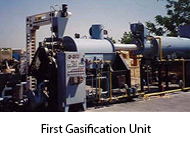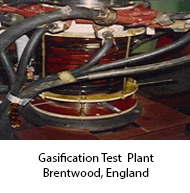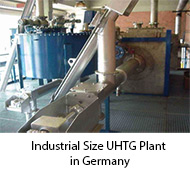history
Technology, Patents & History...
Siltera & Clean Carbon Conversion UHTH History

Since 1984 the company conducted extensive tests, eventually completing research and development of an innovative system to convert liquid and solid waste to a solid, inert product.
Several pilot plants were constructed to prove the system’s abilities and benefits (proof of concept).
Patent Applications

In 1992, patent applications were filed worldwide to cover the inventions which resulted from the past research work and consequently a larger pilot plant was built in Ninove, Belgium, permitting test work on a large scale. A cooperation agreement was signed with the Belgium Ministry of Environment in order to establish test procedures and conduct a series of tests under the supervision of the Ministry.
In the meantime, the EC in Brussels passed new laws and regulations that became effective immediately in Europe requiring several modifications of the existing Siltera UHTG recipes. Parts of the process were subsequently redesigned in order to meet the new rules.
High Temperature Gassification

In 1993, the company developed a new innovative high-temperature gasification system permitting the conversion of energy briquettes or pellets (made out of municipal or toxic waste) to clean electricity without harmful emissions. This development required the assistance of a number of scientists from Germany, Switzerland, the USA and Russia. This process was patented in 1993.
Testing of a new, improved gasification system, based on the use of technically highly advanced heat-resistant material and induction electricity, was completed early 1995. A fourth patent covering this new process was applied for worldwide in the same year. The basis of this research and development work was done at the Metallurgical Institute of Moscow, Russia.
The Siltera UHTG ultra-high temperature gasification plant effectively reduces the organic components of the Siltera UHTG briquettes and pellets made from municipal or toxic waste.
The Pyro Converter

The pyro-converter employs ultra-high temperatures in an oxygen free atmosphere. The temperatures in excess of 1300°C are achieved by using the patented induction reactor, a revolutionary new approach. In this system, solid organic compounds enter the stage of pyrosylates and vapor. The pyrosylate is an inert, inorganic material that is non-leachable and harmless to the environment, the product can be sold on the market.The obtained calorific gas is then used to operate a gas with a generator to produce electricity.
German Test Plant

In June 1995, the Siltera UHTG process was, for the first time, introduced to an international audience at the occasion of the Exhibition Envirotech 95 in Düsseldorf, German.
At the beginning of 1999, a test plant was delivered to a public wastewater treatment plant, in Germany, in order to treat heavily contaminated sludge. This plant was operational until mid-2002 and allowed the company to gain enormously valuable field experience.
Siltera established the first commercial operation at a waste treatment plant close to the Munich Airport under an operating permit that covers 21 different waste streams. The facility’s purpose was to function as a marketing platform for the international clientele and as reference plant in Germany operating according to German and European environmental laws and regulations, considered to be the most rigorous in the world.
Mobile Demonstration Trailer

The company has also constructed a mobile demonstration trailer that has been used to show the system’s abilities on the spot. The demonstration trailer permits potential clients to have tests conducted with their own material, as well as testing of waste products and residues where they occur. Technical facilities and laboratories in England, Germany and Switzerland support this mobile demonstration laboratory unit.
BimschV 17 Certification
Finally and after 3 years of successful operation the Siltera UHTH process achieved the BimschV 17 certificate for environmental cleanliness. The Patent numbers are PCT/EP 2012/066106 and EP 14162556,6
Clean Carbon Conversion Steam Shift Technology
The company changed its name to CLEAN CARBON CONVERSION AG and introduced another development being Steam Shift technology to the standard ultra-high temperature hydrolysis (gasification) process and is mainly employed when waste material has a high CO content and no humidity.
The same is applicable for the Steam Shift technology as is for the standard process - no elementary oxygen is present in the reactor. The environment is reductive. If required and depending on the humidity, overheated water vapour (over 200°C) is introduced through a nozzle at a strategic point just where the syngas has reached the highest temperature level.
In the process, the carbon atom consumes the oxygen of the water molecule and a mixture of carbon monoxide, carbon dioxide and hydrogen result, thus a synthesis gas is produced.
The oxygen for the gasification of carbon comes merely from the MSW and water molecule, as the process is endothermic there is no danger of explosion. An added advantage is the lower internal consumption of electricity, as less power is required by the induction heating elements.
Contact Us

No toxic emissions and no landfill. The cleanest solution available on the market.

